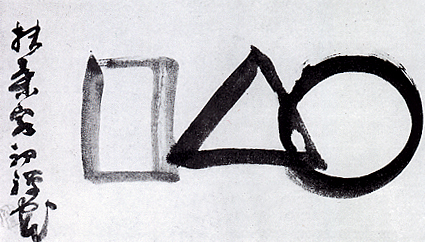| |
The universe is contained in, and expressed through, the yin-yang relationship at the heart of SMiLE. The album's back cover is connected to the universe by way of the Zodiac and the front cover features the same shapes that are used in Sengai's The Universe.
What follows is the Zen monk and teachers work along with an explanation written by D.T.Suzuki in the early sixties. This is how it appears in the book Sengai: The Zen Of Ink And Paper (pgs.36&37).

The Universe"The circle-triangle-square is Sengai's picture of the universe. The circle represents the infinite, and the infinite is at the basis of all beings. But the infinite in itself is formless. We humans endowed with senses and intellect demand tangible forms. Hence a triangle. The triangle is the beginning of all forms. Out of it first comes the square. A square is the triangle doubled. This doubling process goes on infinitely and we have the multitudinosity of things, which the Chinese philosopher calls 'the ten thousand things', that is, the universe. The trouble with us linguistically-minded beings is that we take language realistically and forget that language is of no significance whatsoever without time. In truth, language is time and time is language. We thus come to think that there is in the beginning of the world a something which is real and concrete, such as a world of galaxies which though formless and nebulous is yet real and tangible. This is the foundation of the universe on which we now have all kinds of things, infinitely formed and varied. It is thus that time itself begins to be thought of as something concrete and real. A circle turns into a triangle, and then into a square, and finally into infinitely varied and varying figures. In the same way the Biblical account of creation has turned into historical truth in the minds of many. But Zen is very much against such fabrications.There is another and a more traditional interpretation that may be given to these three figures of forms. Sengai was familiar with Shingon, the mantra sect of Buddhism, as well as Zen. He liked Shingon because it taught the identity of the bodily existence (rupakaya) with ultimate reality (dharmakaya). The bodily existence is here represented by a triangle which symbolizes the human body in its triple aspect, physical, oral (or intellection), and mental (or spiritual). The quadrangle represents the objective world which is composed of the four great elements (mahabhuta), earth, water, fire and air. The Dharmakaya, the ultimate reality, is the circle here, that is, the formless form. We generally hold a dichotomous view of existence, form (rupakaya) and formless (arupa), object and subject, matter and spirit, and think they contradict each other and are mutually exclusive. Both Shingon and Zen, however, oppose this view and hold that what is form is formless or empty (sunya), that is, they are identical.In his little treatise on this subject called Tengan Yaku (Medicine for the Eye), written in a dialogue form, Sengai estimates Zen as being higher than Shingon, and states that Zen is more direct and immediate and to the point without indulging in verbalism. Zen in this respect is the most effective medicinal drop for the eye that is still wandering on the level of intellection. It replaces this kind of eye with the one possessed by Mahasvara (Great Lord). It is the divine eye which looks directly into the secrets of the ultimate reality. The opening or awakening to this order is abrupt and beyond verbal demonstrations of any sort, which is characteristically lacking in Shingon."
~D.T.Suzuki
|
|